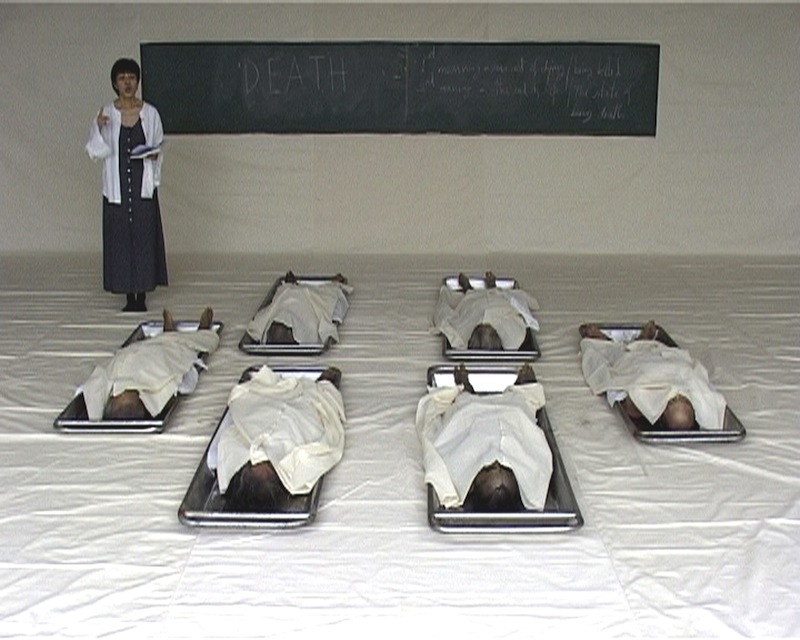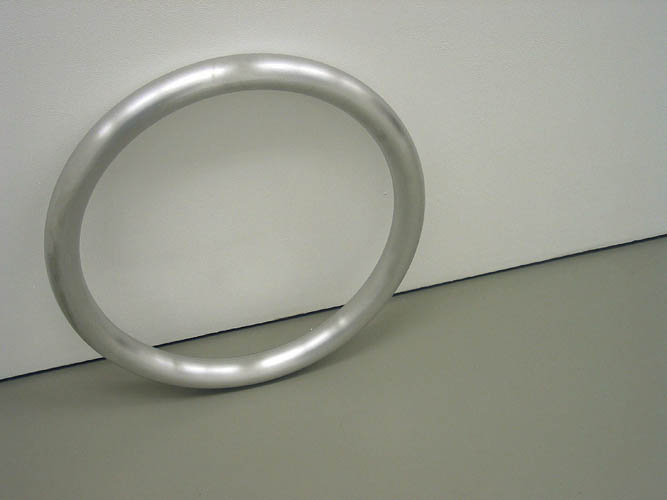They Were Here
2009 - Installation (Installation)
Elisheva Biernoff
In her recent work, Biernoff is interested in investigating fictions and fantasies embedded in the remnants of consumer culture (for example magazines) or through ephemera such as postcards and old photographs. Although the imagery present in her work might seem nostalgic upon first encounter, Biernoff’s complex tableaux often reveal the artist’s skeptical look towards her subjects matters. They Were Here (2010), constitutes a clear example. The 16 ft long tableau confronts the viewer with a seemingly paradisiacal scene: a tropical deserted island with white sands and blooming trees appears to be a coveted destination. However the scene quickly turns into a dystopian image, once one pays attention to the small details camouflaged inside it: an erupting volcano or a dead bird. Biernoff places a pair of binoculars in front of the painting to reinforce this idea. Looking through their fake mdf lenses, the painted landscape is rendered blurry. The whole scene acts up as the backdrop of a theater act and the prop quality of its elements suggests a certain lightness associated with utopian dreams.
Elisheva Biernoff’s work engages and reconsiders the tradition of painting in an interesting way, often taking source material from media or recreating photographs through a careful trompe d’oeil technique. Thus, her work engages in the discussion of re-representation through painting, not aiming to portray any given reality faithfully but rather as the ideal way to engage with a subject matter that explores the intersection between myths, fictions and fantasies. In some cases, her works also address particular ecological concerns.
Colors:
Related works featuring themes of: » Art in Art, » Photorealistic, » Visual Perception, » Contemporary Traces of Memory, » Figurative Art, » Miniature and Small-Scale Paintings, » American

© » KADIST
Yao Jui-Chung
2013Long Long Live (2013) takes the viewer to the setting of the Oasis Villa on Green Island, once a reform and re-education prison to house political prisoners during Taiwan’s martial law period...

© » KADIST
Nathaniel Dorsky
2010Dorsky’s pieces included in the Kadist Collection are small still photographs from twelve of his most important films...

© » KADIST
Matt Lipps
2011Untitled (Women) (2011) presents a startlingly succinct history of violently romanticized femininity...

© » KADIST
John Houck
2013John Houck’s brown- , sienna- and golden-toned composition, Untitled #185, 65, 535 combinations of a 2×2 grid, 16 colors , features densely packed lines of color moving diagonally across the creased page...

© » KADIST
Luke Butler
2008In Captain X , Star Trek’s Captain Kirk, played by William Shatner, is limply draped over a large boulder in what looks like a hostile alien environment...

© » KADIST
John Houck
2013Baby Shoes, Never Worn is part of photographer John Houck’s series of restrained still-life photographs capturing objects from his childhood...

© » KADIST
Araya Rasdjarmrearnsook
2005The Class (2005) by Araya Rasdjarmrearnsook challenges the viewer’s personal sense of morality and tolerance by depicting a classroom from hell...

© » KADIST
Juan Capistran
2002The Breaks reflects Capistran’s interests in sampling and fusing different cultural, social, and historical sources...

© » KADIST
Juan Capistran
2005White Minority , is typical of Capistran’s sampling of high art genres and living subcultures in which the artist subsumes an object’s high art pedigree within a vernacular art form...

© » KADIST
John Houck
2013Houck’s Peg and John was made as part of a series of photographic works that capture objects from the artist’s childhood...

© » KADIST
Conrad Ruiz
2011Conrad Ruiz loves to paint subjects related to the “boy zone”: video games, weapons, games, science fiction, fantasy, and special effects...

© » KADIST
Alessandro Balteo Yazbeck
2008Part of a larger series of photographic works, Alessandro Balteo Yazbeck’s Corrupted file from page 14 (V1) from the series La Vega, Plan Caracas No...

© » KADIST
Ana Teresa Fernández
2011The artist writes about her work Borrando la Frontera, a performance done at Tijuana/San Diego border: “I visually erased the train rails that serve as a divider between the US and Mexico...

© » KADIST
Firenze Lai
2013Central Station, Alignment, and Sumo are “situation portraits” that present whimsical characters within distorted and troubling worlds...

© » KADIST
Jonathan Monk
2003Untitled (rolled up) , is an abstract portrait of Owen Monk, the artist’s father and features an aluminum ring of 56.6 cm in diameter measuring 1.77 cm in circumference, the size of his father...

© » KADIST
Wong Hoy Cheong
2004Re: Looking marks a new phase in Wong’s work which connects his region’s history with other parts of the world...




